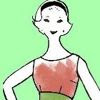"I used to look at our huge basket of family mending, I always dreaded the task ahead of me. Then one day a happy thought struck me. I had- attractive shelves for books, for dishes, for knives, and for kettles. Why didn't I have a little sewing shelf, which would measure up to the rest of the house, a shelf so attractive that it would lend a glamour to the whole task of mending? The reason I disliked mending, I suddenly realized, was because it meant such a terrible waste of time. My tools were never at hand. And so I had kept putting off the job from day to day and the mending collected and grew more and more discouraging.
My plan was quickly carried out. I made a shelf of three-quarter-inch board, three and a half inches wide and twenty-five inches long, with a back to serve as an additional rack. These dimensions make an adequate abiding place for all the articles I need in ordinary sewing and mending work, but offer no refuge for excess baggage. I painted my shelf a gay lacquer red, treating it as an ornament of the room, but I could have matched the color of the wall had I wanted to make it unobtrusive.
When I had completed the outfit I felt very proud of it and hung it in the room where I usually mend, while the children play around or bring me their clothes which need a button or an odd stitch or two. Of course, it was in a good light for both day and night work, and within easy reach of my low sewing chair.
On the back of the rack I drove in six brads at an angle, and on them placed a few necessary spools of thread. Black and white cotton in two weights—one for buttons and the other of lighter weight for hand and machine sewing—were all that I really needed. As I happen to use beige and black silk frequently I gave these a place also. These spools are merely slipped over the brads and can be changed at any time. There is no need to keep a large stock of thread and sewing silk on hand if you are within easy contact with the shops.
Darning stockings is an all important process, if there are children in the home. Also, runners in grown-up stockings are usually discovered just at the sound of the automobile which is to carry you to some special function. To meet both these needs, I have equipped my shelf with four balls of mercerized cotton in the colors most often used. Moreover, since I frequently have to take a stitch in a hurry, each colored cotton has its own needle and this needle I leave in its particular ball, threaded, and ready to use. Then I can arrive at the shelf, pause for a thread, and almost before I realize it, the task is done, and the needle replaced in its particular ball.
Of course, with this darning equipment must go a darning ball. Mine has a handle which will slip into the fingers of gloves, and I accommodated it to my shelf by neatly drilling a hole through the wood. To the thimble I assigned a special place and it is such a comfort to have it always bowing to me as I approach hastily instead of having to hunt for it.
Next on my shelf, I put two small duplex boxes, which are as gay as the heart could wish. These little things hold a few snaps and hooks and all the buttons which the family will need for a few weeks. Buttons are a product with which we are apt to over-supply ourselves. Actually we use very few.
Below the shelf I put a series of small cup-hooks. The first one holds a pincushion and the second a cushion for needles and needles only. I always have a safety pin or two present. I use them to draw various tapes and runners in bloomers and pajamas.
The next hook I definitely assigned to the tape measure. The next holds a woven band of colored darning threads. They are attractive, useful and inexpensive, and no mending shelf is really equipped without one. On the remaining two hooks I hung the scissors. I find two pairs sufficient; one for cutting and the other, a small pointed pair, for fine work. Definite places for things are such a comfort.
With this equipment on hand, even a large order of mending from a ten year-old son loses its deadly effect, and the running time, of all weekly mending is infinitely reduced."

